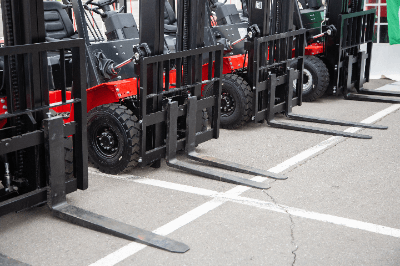What Is a Forklift?

Forklifts are equipment developed to improve the efficiency of cargo transport operations.
It has forks to insert into a pallet and a mast to raise and lower the pallet and is operated by hydraulic or electric power.
Forklift operation requires safety precautions to prevent tipping over and collisions, and requires completion of a prescribed skills training course. When transporting goods, they can be loaded on pallets with holes in the sides and lifted by pointing the forks at the holes.
Uses of Forklifts
Forklifts are used in factories and distribution warehouses to improve the efficiency of cargo handling operations. Forklifts are used to quickly move loads that are difficult to lift by hand.
In recent years, batteries have become the main power source for forklifts, due to their lower exhaust emissions and improved operability. Forklifts are designed to be maneuverable, but smaller, non-powered handlifts are used for moving and transporting in confined spaces.
Principle of Forklifts
The part of the forklift that lifts and carries the load is called the load handling unit, which operates mainly by hydraulic pressure. When high-pressure hydraulic fluid is fed into the cylinder, the cylinder of the load handling unit is moved to lift the load, and when the load is lowered, the hydraulic fluid is returned to the tank to lift and tilt the forks.
A standard load is specified for the weight that can be carried with the forks lifted to a certain height, but when the forks are lifted higher for use, it is important to limit the load capacity in consideration of the center of gravity. The maximum load according to height is indicated on the lift as the allowable load.
It is important to always pay attention to the position of the center of gravity when operating the lift. Carrying a load in excess of the allowable load capacity or tilt operation with the forks raised high is prohibited because the center of gravity will move forward and upward, causing the lift to tip over. When traveling uphill, the forks should be moved forward and backward.
Types of Forklifts
Forklifts are mainly classified into five types
1. Counter Lift
This is the most common type of forklift and is constructed to withstand heavy weights. Weights are installed at the rear of the vehicle body to maintain equilibrium when lifting and carrying heavy objects. The vehicle body is stable, can be operated from a seated position, and the forklift is fast. However, the vehicle body is large and is not suitable for use in confined spaces.
2. Reach Forklift Truck
The forks can be moved back and forth without moving. Operated from a standing position, the forks can be pulled inward regardless of the weight of the load. Tires rotate 90°, making it easy to maneuver indoors and in other confined spaces.
3. Side Forklift
The forks are located next to the vehicle body, and the operator’s seat is high. It has a wide cargo bed and is suitable for transporting long items such as pipes and lumber.
4. Walkie Forklift Truck
It can be moved by hand while the operator walks without getting into the vehicle. Since it is electrically powered, it does not require much force to move by hand. Its compact size allows it to move in narrow aisles, and it can be loaded and unloaded in an elevator.
5. Multi-Directional Forklift
The forklift can move not only forward and backward but also sideways. Because it can move sideways, it does not need to turn around in narrow aisles.
Structure of Forklifts
Forklifts are powered by either storage batteries or internal combustion engines.
1. Battery-Powered
The electricity stored in the battery powers the motor. Battery-type storage batteries have been widely used in forklifts since early times. At present, battery-type forklifts are often used in small forklifts of 3 tons or less.
Battery-powered forklifts make little noise and are suitable for working in residential areas late at night or early in the morning. They are environmentally friendly as they do not emit exhaust gases and are safe even in closed areas such as refrigerated warehouses.
2. Internal Combustion Engine Type
This type uses gasoline, compressed natural gas, liquefied petroleum gas, or diesel as fuel. Diesel is often used when power is more important than speed. However, exhaust fumes pose a health risk and they cannot be used in enclosed areas.